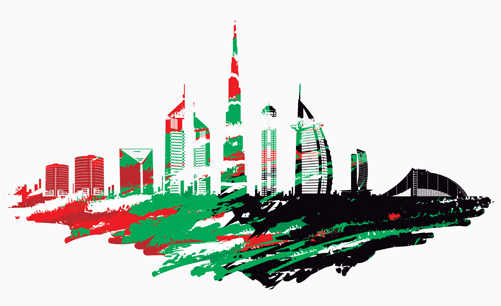
The United Arab Emirates, often abbreviated as UAE or shortened to The Emirates (Arabic: الامارات Al Imārāt), is a federation situated in the southeast of the Arabian Peninsula in Southwest Asia on the Persian Gulf, bordering Oman and Saudi Arabia and sharing sea borders with Iraq, Kuwait, Bahrain, Qatar and Iran.
Termed emirates because they are ruled by emirs, they are Abu Dhabi, Ajman, Dubai, Fujairah, Ras al-Khaimah, Sharjah and Umm al-Quwain. The capital is Abu Dhabi, which is also the country’s center of political, industrial and cultural activities.
Before 1971, the UAE was known as the Trucial States or Trucial Oman, in reference to a 19th-century truce between the United Kingdom and several Arab Sheikhs. The name Pirate Coast was also used in reference to the area’s emirates from the 18th to the early 20th century.
The UAE’s political system, based on its 1971 Constitution, is composed of several intricately connected governing bodies. Islam is the official religion, and Arabic is the official language.
The UAE’s oil reserves are the seventh-largest in the world while its natural gas reserves are the world’s seventeenth-largest. S
Although the UAE has a constitution and a president, it is neither a constitutional monarchy nor a republic. It is a federation of seven monarchies, whose rulers retain absolute power within their emirates. The emirs chose one of their number to be the president of the federation, but this does not alter the monarchical character of the government of the emirates. The constitution is concerned solely with the relations between the emirates as members of the federation, and does not prescribe a constitutional system of government.
The UAE is a founding member of the Cooperation Council for the Arab States of the Gulf, and a member state of the Arab League. It is also a member of the United Nations, the Organisation of Islamic Cooperation, OPEC, and the World Trade Organization.
The United Arab Emirates is situated in Southwest Asia, bordering the Gulf of Oman and the Persian Gulf, between Oman and Saudi Arabia; it is in a strategic location along southern approaches to the Strait of Hormuz, a vital transit point for world crude oil.
A view of the desert landscape on the outskirts of Dubai
The mountainous region in the north
The UAE lies between 22°30′ and 26°10′ north latitude and between 51° and 56°25′ east longitude. It shares a 530-kilometer border with Saudi Arabia on the west, south, and southeast, and a 450-kilometer border with Oman on the southeast and northeast. The land border with Qatar in the Khawr al Udayd area is about nineteen kilometers in the northwest; however, it is a source of ongoing dispute. The total area of the UAE is approximately 77,700 square kilometers. The country’s exact size is unknown because of disputed claims to several islands in the Persian Gulf, because of the lack of precise information on the size of many of these islands, and because most of its land boundaries, especially with Saudi Arabia, remain undemarcated.[38] Additionally, island disputes with Iran and Qatar remain unresolved.
The largest emirate, Abu Dhabi, accounts for 87% of the UAE’s total area (67,340 square kilometers). The smallest emirate, Ajman, encompasses only 259 square kilometers (see figure).
The UAE coast stretches for more than 650 kilometers along the southern shore of the Persian Gulf. Most of the coast consists of salt pans that extend far inland. The largest natural harbor is at Dubai, although other ports have been dredged at Abu Dhabi, Sharjah, and elsewhere. Numerous islands are found in the Persian Gulf, and the ownership of some of them has been the subject of international disputes with both Iran and Qatar. The smaller islands, as well as many coral reefs and shifting sandbars, are a menace to navigation. Strong tides and occasional windstorms further complicate ship movements near the shore. The UAE also has a stretch of the Al Bāţinah coast of the Gulf of Oman, although the Musandam Peninsula, the very tip of Arabia by the Strait of Hormuz is an enclave of Oman within the UAE.
South and west of Abu Dhabi, vast, rolling sand dunes merge into the Rub al-Khali (Empty Quarter) of Saudi Arabia. The desert area of Abu Dhabi includes two important oases with adequate underground water for permanent settlements and cultivation. The extensive Liwa Oasis is in the south near the undefined border with Saudi Arabia. About 100 kilometers to the northeast of Liwa is the Al-Buraimi oasis, which extends on both sides of the Abu Dhabi-Oman border.
Prior to withdrawing from the area in 1971, Britain delineated the internal borders among the seven emirates in order to preempt territorial disputes that might hamper formation of the federation. In general, the rulers of the emirates accepted the British intervention, but in the case of boundary disputes between Abu Dhabi and Dubai, and also between Dubai and Sharjah, conflicting claims were not resolved until after the UAE became independent. The most complicated borders were in the Al-Hajar al-Gharbi Mountains, where five of the emirates contested jurisdiction over more than a dozen enclaves.
| Capital | Abu Dhabi 24°28′N 54°22′E |
|
| Largest city | Dubai | |
|---|---|---|
| Official language(s) | Arabic | |
| Ethnic groups | 9.5% Arabs, 90.5% South Asian, Indian, Pakistani, Bangladeshi, Chinese, Filipino, Thai, Iranian, Westerners (2009) | |
| Demonym | Emirati | |
| Government | Federal presidential system and elective constitutional monarchy | |
| – | President | Khalifa bin Zayed Al Nahyan |
| – | Vice President and Prime Minister | Mohammed bin Rashid Al Maktoum |
| Legislature | Federal National Council | |
| Sovereignty | End of special treaty with the United Kingdom | |
| – | Constitution | December 2, 1971 |
| Area | ||
| – | Total | 83,600 km2 (116th) 32,278 sq mi |
| – | Water (%) | negligible |


 Русский
Русский Español
Español